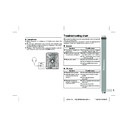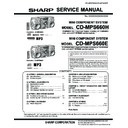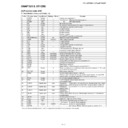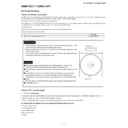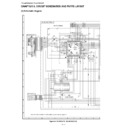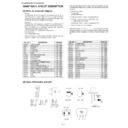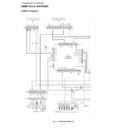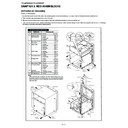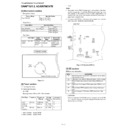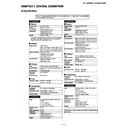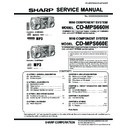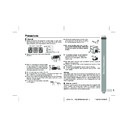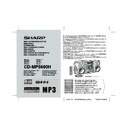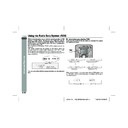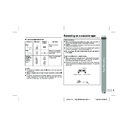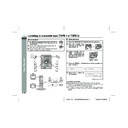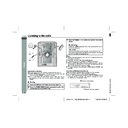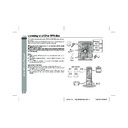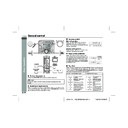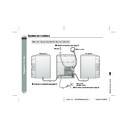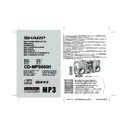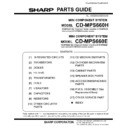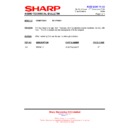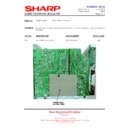Read Sharp CD-MPS660H (serv.man10) User Guide / Operation Manual online
03/12/19
CD-MPS660H(H)E4.fm
E-40
ENGLISH
8
CD-MPS660H
TINSZA035AWZZ
Refe
rences
"
Headphones
!
Before plugging in or unplugging the headphones, reduce the
volume.
volume.
!
Be sure your headphones have a 3.5 mm (1/8") diameter plug
and are between 16 ohms and 50 ohms impedance. The recom-
mended impedance is 32 ohms.
and are between 16 ohms and 50 ohms impedance. The recom-
mended impedance is 32 ohms.
!
Plugging in the headphones disconnects the speakers automati-
cally. Adjust the volume using the VOLUME control.
cally. Adjust the volume using the VOLUME control.
Troubleshooting chart
Many potential problems can be resolved by the owner without call-
ing a service technician.
If something is wrong with this product, check the following before
calling your authorised SHARP dealer or service centre.
ing a service technician.
If something is wrong with this product, check the following before
calling your authorised SHARP dealer or service centre.
"
General
"
CD player
Symptom
Possible cause
!
The clock is not set to the
correct time.
correct time.
!
Did a power failure occur? Reset
the clock. (Refer to page 12.)
the clock. (Refer to page 12.)
!
When a button is pressed,
the unit does not respond.
the unit does not respond.
!
Set the unit to the power stand-
by mode and then turn it back on.
by mode and then turn it back on.
!
If the unit still malfunctions, reset
it. (Refer to page 42.)
it. (Refer to page 42.)
!
No sound is heard.
!
Is the volume level set to "0"?
!
Are the headphones connected?
!
Are the speaker wires discon-
nected?
nected?
Symptom
Possible cause
!
Playback does not start.
!
Is the disc loaded upside down?
!
Playback stops in the mid-
dle or is not performed
properly.
dle or is not performed
properly.
!
Does the disc satisfy the stan-
dards?
dards?
!
Is the disc distorted or
scratched?
scratched?
!
Playback sounds are
skipped, or stopped in the
middle of a track.
skipped, or stopped in the
middle of a track.
!
Is the unit located near excessive
vibrations?
vibrations?
!
Is the disc very dirty?
!
Has condensation formed inside
the unit?
the unit?
03/12/19
CD-MPS660H(H)E4.fm
E-41
ENGLISH
CD-MPS660H
TINSZA035AWZZ
Refe
rences
Troubleshooting chart (continued)
!
Cassette deck
!
Remote control
!
Tuner
!
Condensation
Sudden temperature changes, storage or operation in an extremely
humid environment may cause condensation inside the cabinet (CD
pickup, tape heads, etc.) or on the transmitter on the remote control.
Condensation can cause the unit to malfunction. If this happens,
leave the power on with no disc (or cassette) in the unit until normal
playback is possible (about 1 hour). Wipe off any condensation on
the transmitter with a soft cloth before operating the unit.
humid environment may cause condensation inside the cabinet (CD
pickup, tape heads, etc.) or on the transmitter on the remote control.
Condensation can cause the unit to malfunction. If this happens,
leave the power on with no disc (or cassette) in the unit until normal
playback is possible (about 1 hour). Wipe off any condensation on
the transmitter with a soft cloth before operating the unit.
Symptom
Possible cause
"
Cannot record.
"
Is the erase-prevention tab re-
moved?
moved?
"
Cannot record tracks with
proper sound quality.
proper sound quality.
"
Is it a normal tape? (You cannot
record on a metal or CrO tape.)
record on a metal or CrO tape.)
"
Cannot erase completely.
"
Sound skipping.
"
Is there slack in the tape?
"
Is the tape stretched?
"
Cannot hear treble.
"
Are the capstans, pinch rollers,
or heads dirty?
or heads dirty?
"
Sound fluctuation.
"
Cannot remove the tape.
"
If a power failure occurs during
playback, the heads remain en-
gaged with the tape. Do not open
the compartment with great
force.
playback, the heads remain en-
gaged with the tape. Do not open
the compartment with great
force.
Symptom
Possible cause
"
The remote control does
not operate.
not operate.
"
Is the AC power lead of the unit
plugged in?
plugged in?
"
Is the battery polarity correct?
"
Are the batteries dead?
"
Is the distance or angle incor-
rect?
rect?
"
Does the remote control sensor
receive strong light?
receive strong light?
Symptom
Possible cause
"
The radio makes unusual
noises continuously.
noises continuously.
"
Is the unit placed near the TV or
computer?
computer?
"
Is the FM aerial or AM loop aerial
placed properly? Move the aerial
away from the AC power lead if
it's located nearby.
placed properly? Move the aerial
away from the AC power lead if
it's located nearby.
03/12/19
CD-MPS660H(H)E4.fm
E-42
ENGLISH
8
CD-MPS660H
TINSZA035AWZZ
Refe
rences
!
If trouble occurs
When this product is subjected to strong external interference
(mechanical shock, excessive static electricity, abnormal supply
voltage due to lightning, etc.) or if it is operated incorrectly, it may
malfunction.
If such a problem occurs, do the following:
1
(mechanical shock, excessive static electricity, abnormal supply
voltage due to lightning, etc.) or if it is operated incorrectly, it may
malfunction.
If such a problem occurs, do the following:
1
Set the unit to the stand-by mode and turn the power on again.
2
If the unit is not restored in the previous operation, unplug and
plug in the unit, and then turn the power on.
plug in the unit, and then turn the power on.
Note:
If neither operation above restores the unit, clear all the memory by
resetting it.
If neither operation above restores the unit, clear all the memory by
resetting it.
!
Clearing all the memory (reset)
1
Press the ON/STAND-BY button to enter the power stand-by
mode.
mode.
2
Whilst pressing down the
button and the X-BASS/DEMO but-
ton, press the
PRESET button until "CLEAR ALL"
appears.
Caution:
This operation will erase all data stored in memory including clock,
timer settings, tuner preset, and CD programme.
!
Before transporting the unit
Remove all CDs from the unit. Make sure there is no CD in the disc
tray. Then, set the unit to the power stand-by mode. Carrying the
unit with discs left inside can damage the unit.
tray. Then, set the unit to the power stand-by mode. Carrying the
unit with discs left inside can damage the unit.
!
Care of compact discs
Compact discs are fairly resistant to damage, however mistracking
can occur due to an accumulation of dirt on the disc surface. Follow
the guidelines below for maximum enjoyment from your CD collec-
tion and player.
can occur due to an accumulation of dirt on the disc surface. Follow
the guidelines below for maximum enjoyment from your CD collec-
tion and player.
"
Do not write on either side of the disc, particularly the non-label
side from which signals are read. Do not mark this surface.
side from which signals are read. Do not mark this surface.
"
Keep your discs away from direct sunlight, heat, and excessive
moisture.
moisture.
"
Always hold the CDs by the edges. Fingerprints, dirt, or water on
the CDs can cause noise or mistracking. If a CD is dirty or does
not play properly, clean it with a soft, dry cloth, wiping straight out
from the centre, along the radius.
the CDs can cause noise or mistracking. If a CD is dirty or does
not play properly, clean it with a soft, dry cloth, wiping straight out
from the centre, along the radius.
NO
YES
Correct
Correct
03/12/19
CD-MPS660H(H)E4.fm
E-43
ENGLISH
CD-MPS660H
TINSZA035AWZZ
Refe
rences
Maintenance
!
Cleaning the tape-handling parts
"
Dirty heads, capstans or pinch rollers can cause poor sound and
tape jams. Clean these parts with a cotton swab moistened with
commercial head/pinch roller cleaner or isopropyl alcohol.
tape jams. Clean these parts with a cotton swab moistened with
commercial head/pinch roller cleaner or isopropyl alcohol.
"
When cleaning the heads, pinch rollers, etc., unplug the unit
which contains high voltages.
which contains high voltages.
"
After long use, the deck's heads and capstans may become mag-
netised, causing poor sound. Demagnetise these parts once
every 30 hours of playing/recording time by using a commercial
tape head demagnetiser. Read the demagnetiser's instructions
carefully before use.
netised, causing poor sound. Demagnetise these parts once
every 30 hours of playing/recording time by using a commercial
tape head demagnetiser. Read the demagnetiser's instructions
carefully before use.
!
Cleaning the cabinet
Periodically wipe the cabinet with a soft cloth and a diluted soap
solution, then with a dry cloth.
solution, then with a dry cloth.
Caution:
"
Do not use chemicals for cleaning (petrol, paint thinner, etc.). It
may damage the cabinet finish.
may damage the cabinet finish.
"
Do not apply oil to the inside of the unit. It may cause malfunc-
tions.
tions.
Specifications
As part of our policy of continuous improvement, SHARP reserves
the right to make design and specification changes for product
improvement without prior notice. The performance specification fig-
ures indicated are nominal values of production units. There may be
some deviations from these values in individual units.
the right to make design and specification changes for product
improvement without prior notice. The performance specification fig-
ures indicated are nominal values of production units. There may be
some deviations from these values in individual units.
!
General
!
Amplifier
Playback head
Erase head
Capstan
Recording/Playback head
Pinch roller
TAPE 1
TAPE 2
A
C
B
C
D
E
B
Power source
AC 230 V, 50 Hz
Power
consumption
consumption
Power on: 110 W
Power stand-by: 0.6 W (*)
Dimensions
Width: 260 mm (10-1/4")
Height: 330 mm (13")
Depth: 326 mm (12-7/8")
Height: 330 mm (13")
Depth: 326 mm (12-7/8")
Weight
7.8 kg (17.2 lbs.)
( * )This power consumption value is obtained when the demonstra-
tion mode is cancelled in the power stand-by mode. Refer to
page 9 to cancel the demonstration mode.
page 9 to cancel the demonstration mode.
Output power
PMPO: 880 W
MPO: 440 W (220 W + 220 W) (DIN 45 324)
RMS: 240 W (120 W + 120 W) (DIN 45 324)
RMS: 160 W (80 W + 80 W) (DIN 45 500)
Output terminals
Speakers: 6 ohms
Headphones: 16 - 50 ohms
(recommended: 32 ohms)
(recommended: 32 ohms)
Video output: 1Vp-p
Input terminals
Game/ Auxiliary (audio signal):
500 mV/ 47 k ohms
500 mV/ 47 k ohms
Game/Video: 1Vp-p
23
SHARP
T
INSZA0
3
5
A
W
Z
Z
Z
(H
)
)

